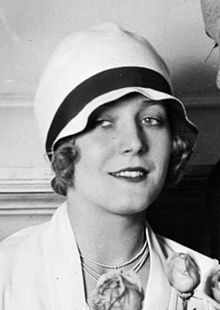Vilma Bánky
Vilma Bánky (born January 9, 1901 in Nagydorog , Hungary , † March 18, 1991 in Los Angeles , California ) was a Hungarian actress . She was one of the most famous stars in Hollywood towards the end of the silent film era. At the height of her career, she became known as the Hungarian Rhapsody .
Career
Vilma Bánky had already made a number of films in Europe, including Max, the Circus King with Max Linder , when producer Samuel Goldwyn discovered her in 1925 and gave her a studio contract . An outspoken beauty with blonde hair and blue eyes, she already created a sensation with her debut The Eagle alongside Rudolph Valentino . It was hailed as an exciting discovery by the press and for a while even outshone the rise of another European discovery: Greta Garbo , who was under contract with MGM . After another success alongside Valentino in George Fitzmaurice 's costume drama The Sheikh's Son , Bánky found her perfect partner in Ronald Colman , who was also under contract with Goldwyn. Both made The Dark Angel , a mystical story about love and renunciation among war veterans. The film was one of the biggest box office hits of the year, turning Colman-Bánky into one of the big screen dream couples of the late 1920s in Hollywood. Her success in The Winning of Barbara Worth , directed by Henry King in 1926 with a lot of money - a good $ 800,000 - caused all other studios to look for dream couples as well. Some attempts have been successful, such as Garbo / John Gilbert for MGM or Janet Gaynor / Charles Farrell for Fox. Others failed after just one attempt, like the one trying to make Paramount's Glorious Young Lovers out of Fay Wray and Gary Cooper . Bánky and Colman shot other romantic adventures, most of which took place in a transfigured Europe. For example, The Night of Love showed Colman in 1927 as a prince disguised as a gypsy and falling in love with the bride of his enemy. A particularly subtle critic wrote the following non-translatable pun about the film:
- After some hanky-panky with Banky, Colman takes her to his gypsy camp. Gypsy camp aptly describes this mishmash of several movie clichés.
In the same year they shot The Magic Flame , which presented him as a circus clown who has to take on the role of a king and she as a trapeze artist. Dissatisfied with the constant repetition of the same roles, they ended their collaboration with Two Lovers in 1928. As usual, Colman was a prince in disguise who, this time during the Netherlands Eighty Years War, saves the wife of his greatest enemy and falls in love with her. Bánky put an end to all speculation about a romance with her marriage to Hollywood star Rod La Rocque in the same year. Goldwyn was paying his biggest female star a good $ 6,000 a week at the time, urging her to take more focused English lessons as the soundtrack loomed. Bánky made another silent film, The Awakening , which was not very successful , which was set shortly after the Franco-Prussian War of 1870, and then turned to the microphone in 1929, when the recording technology had already improved. In contrast to the stage-tested Ronald Colman, Bánky was overwhelmed with the demands of talking films. Her voice has been described as pleasant but devoid of character. One less compassionate critic even wrote of her film This Is Heaven , which presented her as a Hungarian immigrant, that she had a "strange accent that sounds like a mix of Chicago and Budapest."
After the failure, Goldwyn did not renew her contract. At the end of 1929, Bánky shot a remake of Pola Negri 's previous year's flop The Secret Hour under the title A Lady to Love, directed by Victor Sjöström . Edward G. Robinson was her partner, who later wrote in his autobiography that she was simply too beautiful for the part of a desperate waitress who marries a bitter winemaker and cheats on him with his foreman. After that, Vilma Bánky's American career was over. She spent the next several decades hosting good friends and on the golf course.
Filmography (selection)
- 1923: The portrait
- 1924: Max, the king of the circus
- 1924: The Forbidden Land
- 1924: Hotel Potemkin
- 1925: The Dark Angel *
- 1925: The Eagle (The Eagle)
- 1926: The Winning of Barbara Worth *
- 1926: The Son of the Sheik (The Son of the Sheik)
- 1927: The Night of Love *
- 1927: The Magic Flame *
- 1928: Two Lovers *
- 1928: The journey into the fire (The Awakening)
- 1929: This Is Heaven
- 1930: A Lady to Love
- 1932: The Rebel (US version of the German film Der Rebel )
Films with Ronald Colman are marked with an asterisk (*).
Web links
- Vilma Bánky in the Internet Movie Database (English)
- Brief biography
- Pictures by Vilma Bánky In: Virtual History
- Extensive image material ( memento from January 20, 2013 in the Internet Archive )
Individual evidence
- ↑ National Archives of Hungary microfilm 30790, image 291, fiche third
| personal data | |
|---|---|
| SURNAME | Bánky, Vilma |
| BRIEF DESCRIPTION | Hungarian actress |
| DATE OF BIRTH | January 9, 1901 |
| PLACE OF BIRTH | Nagydorog , Hungary |
| DATE OF DEATH | March 18, 1991 |
| Place of death | Los Angeles , California |
